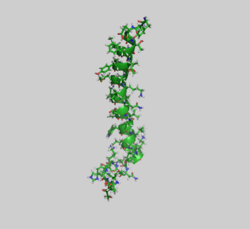Top Qs
Timeline
Chat
Perspective
Gastric inhibitory polypeptide
Mammalian protein found in Homo sapiens From Wikipedia, the free encyclopedia
Remove ads
Gastric inhibitory polypeptide (GIP), also known as glucose-dependent insulinotropic polypeptide, is an inhibiting hormone of the secretin family of hormones.[5] While it is a weak inhibitor of gastric acid secretion, its main role, being an incretin, is to stimulate insulin secretion.[6]
GIP, along with glucagon-like peptide-1 (GLP-1), belongs to a class of molecules referred to as incretins,[7] which stimulate insulin release on oral food intake.
Remove ads
Synthesis and transport
GIP is derived from a 153-amino acid proprotein encoded by the GIP gene and circulates as a biologically active 42-amino acid peptide. It is synthesized by K cells, which are found in the mucosa of the duodenum and the jejunum of the gastrointestinal tract.[8]
Like all endocrine hormones, it is transported by blood.
Gastric inhibitory polypeptide receptors are seven-transmembrane proteins (GPCRs) found on beta-cells in the pancreas.
Remove ads
Functions
Summarize
Perspective
It has traditionally been named gastrointestinal inhibitory peptide or gastric inhibitory peptide and was found to decrease the secretion of stomach acid[9] to protect the small intestine from acid damage, reduce the rate at which food is transferred through the stomach, and inhibit the GI motility and secretion of acid. However, this is incorrect, as it was discovered that these effects are achieved only with higher-than-normal physiological level, and that these results naturally occur in the body through a similar hormone, secretin.[10]
It is now believed that the function of GIP is to induce insulin secretion, which is stimulated primarily by hyperosmolarity of glucose in the duodenum.[11] After this discovery, some researchers prefer the new name of glucose-dependent insulinotropic peptide, while retaining the acronym "GIP." The amount of insulin secreted is greater when glucose is administered orally than intravenously.[12]
In addition to its role as an incretin, GIP is known to inhibit apoptosis of the pancreatic beta cells and to promote their proliferation. It also stimulates glucagon secretion and fat accumulation. GIP receptors are expressed in many organs and tissues including the central nervous system enabling GIP to influence hippocampal memory formation and regulation of appetite and satiety.[13]
GIP recently appeared as a major player in bone remodeling. Researchers at Universities of Angers and Ulster evidenced that genetic ablation of the GIP receptor in mice resulted in profound alterations of bone microarchitecture through modification of the adipokine network.[14] Furthermore, the deficiency in GIP receptors has also been associated in mice with a dramatic decrease in bone quality and a subsequent increase in fracture risk.[15] However, the results obtained by these groups are far from conclusive because their animal models give discordant answers and these works should be analysed very carefully.[citation needed]
Remove ads
Pathology
It has been found that type 2 diabetics are not responsive to GIP and have lower levels of GIP secretion after a meal when compared to non-diabetics.[16] In research involving knockout mice, it was found that absence of the GIP receptors correlates with resistance to obesity.[17]
Tirzepatide
Tirzepatide is an analog of the human GIP hormone with a C20 fatty diacid portion attached, that has been approved for treatment of diabetes in the US in May 2022.
References
External links
Wikiwand - on
Seamless Wikipedia browsing. On steroids.
Remove ads





